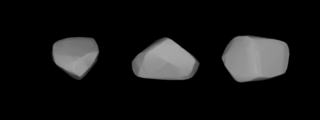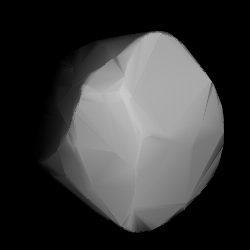
Achilles is a large Jupiter trojan asteroid of the Greek camp. Achilles was the first Jupiter trojan to be discovered, and was discovered by Max Wolf at the Heidelberg Observatory in 1906. Wolf named the minor planet after the legendary hero Achilles from Greek mythology. The dark D-type asteroid measures approximately 133 kilometers in diameter which makes it one of the 10 largest Jupiter trojans. It has a rotation period of 7.3 hours and possibly a spherical shape.

Diana is a large and dark main-belt asteroid. It was discovered by German astronomer Robert Luther on March 15, 1863, and named after Diana, Roman goddess of the hunt. The asteroid is orbiting the Sun at a distance of 2.620 AU with a period of 4.24 years and an eccentricity (ovalness) of 0.207. The orbital plane is tilted at an angle of 8.688° relative to the plane of the ecliptic. Its composition is carbonaceous and primitive.

Lachesis is a large main-belt asteroid. It was discovered by French astronomer Alphonse Borrelly on April 10, 1872, and independently by German-American astronomer Christian Heinrich Friedrich Peters on April 11, 1872, then named after Lachesis, one of the Moirai, or Fates, in Greek mythology. A Lachesean occultation of a star occurred in 1999 and was confirmed visually by five observers and once photoelectrically, with the chords yielding an estimated elliptical cross-section of 184 × 144 km.

Medusa is a bright-coloured, stony main-belt asteroid that was discovered by French astronomer J. Perrotin on September 21, 1875, and named after the Gorgon Medusa, a snake-haired monster in Greek mythology. It is orbiting the Sun at a distance of 2.17 AU with a period of 3.21 years and an eccentricity of 0.065. The orbital plane is tilted slightly at an angle of 0.94° to the plane of the ecliptic.

Bertha is a main-belt asteroid. It was discovered by the French brothers Paul Henry and Prosper Henry on 4 November 1875, but the credit for the discovery was given to Prosper. It is probably named after Berthe Martin-Flammarion, sister of the astronomer Camille Flammarion.

Koronis is a main-belt asteroid that was discovered by Russian astronomer Viktor Knorre on January 4, 1876, from the Berlin observatory. It was the first of his four asteroid discoveries. The meaning of the asteroid name is uncertain, but it may come from Coronis the mother of Asclepius from Greek mythology. Alternatively, it may come from Coronis, a nymph of the Hyades sisterhood. The Koronis family is named after this asteroid.

Urda is a main-belt asteroid that was discovered by German-American astronomer Christian Heinrich Friedrich Peters on August 28, 1876, in Clinton, New York, and named after Urd, one of the Norns in Norse mythology. In 1905, Austrian astronomer Johann Palisa showed that the asteroid varied in brightness.

225 Henrietta is a very large outer main-belt asteroid. It was discovered by Austrian astronomer Johann Palisa on April 19, 1882, in Vienna and named after Henrietta, wife of astronomer Pierre J. C. Janssen. The asteroid is orbiting at a distance of 3.39 AU from the Sun with a period of 6.24 years and an eccentricity (ovalness) of 0.26. The orbital plane is inclined at an angle of 20.9° to the plane of the ecliptic. 225 Henrietta belongs to Cybele group of asteroids and is probably in a 4:7 orbital resonance with the planet Jupiter.

402 Chloë is a large main-belt asteroid. It was discovered by French astronomer Auguste Charlois on 21 March 1895 from Nice. This asteroid is orbiting the Sun at a distance of 2.56 AU with a period of 4.09 years and an eccentricity of 0.11. The orbital plane is inclined at an angle of 11.8° to the plane of the ecliptic.

Edburga is a typical Main belt asteroid. Max Wolf discovered it on 7 January 1896 at Heidelberg Observatory. The origin of the name is unknown. This asteroid is orbiting the Sun at a distance of 2.58 AU with a period of 4.15 yr and an eccentricity of 0.34. Its orbital plane is inclined at an angle of 18.7° to the plane of the ecliptic.
464 Megaira is a dark and large background asteroid, approximately 77 kilometers in diameter, located in the central region of the asteroid belt. It was discovered by astronomer Max Wolf at the Heidelberg Observatory in southwest Germany on 9 January 1901. The carbonaceous C-type asteroid (FX) has a rotation period of 12.9 hours. It was named after Megaera from Greek mythology.
Kressida is a minor planet orbiting the Sun. This object was discovered by German astronomer Paul Götz in 1904. It is named after the theatrical character Cressida. This stony S-type asteroid is orbiting at a distance of 2.28 AU from the Sun, with an orbital eccentricity (ovalness) of 0.185 and a period of 3.45 yr. The orbital plane is inclined at an angle of 3.87° to the ecliptic.
718 Erida is a minor planet orbiting the Sun. It was discovered at Vienna on September 29, 1911, by Austrian astronomer Johann Palisa, and was named for Erida Leuschner, daughter of astronomer Armin Otto Leuschner. It is orbiting at a distance of 3.06 AU with a period of 5.34 yr and an eccentricity of 0.20. The orbital plane of this asteroid is inclined by an angle of 6.9° to the plane of the ecliptic.
737 Arequipa is a minor planet orbiting the Sun. It was discovered by American astronomer Joel Hastings Metcalf on 7 December 1912 from Winchester, Massachusetts. This stony S-type asteroid was named after the Peruvian city of Arequipa, where Harvard's Boyden Observatory was located prior to 1927. It is orbiting at a distance of 2.59 AU from the Sun, with an orbital eccentricity (ovalness) of 0.245 and a period of 4.17 yr. The orbital plane is inclined at an angle of 12.4° to the ecliptic.
785 Zwetana is a minor planet orbiting the Sun that was discovered by Adam Massinger, an assistant at the Heidelberg Observatory, on March 30, 1914. It was named for the daughter of Kiril Popoff, a Bulgarian astronomer. This asteroid is orbiting 2.57 AU from the Sun with an eccentricity (ovalness) of 0.21 and a period of 4.12 yr. The orbital plane is inclined by an angle of 12.8° to the plane of the ecliptic.
815 Coppelia is a minor planet orbiting the Sun that was discovered by German astronomer Max Wolf on 2 February 1916 from Heidelberg named after Coppélia, a comic ballet.

1299 Mertona is a bright background asteroid from the central region of the asteroid belt. It was discovered on 18 January 1934, by French astronomer Guy Reiss at Algiers Observatory, Algeria, in northern Africa. The likely stony asteroid with an unknown spectral type has a rotation period of 5.0 hours and measures approximately 14 kilometers in diameter. It was named after English astronomer Gerald Merton.
13260 Sabadell, prov. designation: 1998 QZ15, is a stony Eunomia asteroid from the central region of the asteroid belt. It was discovered by Catalan amateur astronomers Ferran Casarramona and Antoni Vidal at the Montjoia Observatory (953), Barcelona, on 23 August 1998. The likely elongated asteroid measures approximately 5.3 kilometers (3.3 miles) in diameter and has a rotation period of 5.3 hours. It was named after the astronomical society "Agrupació Astronòmica de Sabadell".
10208 Germanicus, provisional designation 1997 QN1, is a stony Florian asteroid and binary system from the inner regions of the asteroid belt, approximately 3.5 kilometers in diameter.
6250 Saekohayashi, provisional designation 1991 VX1, is a bright Hungaria asteroid and relatively slow rotator from the inner regions of the asteroid belt, approximately 3.7 kilometers in diameter. It was discovered on 2 November 1991, by American astronomer Eleanor Helin at Palomar Observatory in California, and later named after Japanese astronomer Saeko Hayashi.











